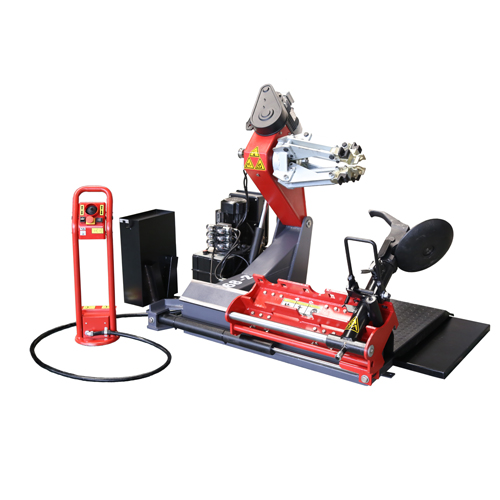How to maintain the S-T568 tire changer
The S-T568 tire changer is a commonly used piece of equipment in tire repair operations. Proper daily maintenance can extend its service life and ensure accuracy and safety. The following is a detailed maintenance guide covering different components and cycles:
1. Daily maintenance (before and after each use)
① Clean the surface of the equipment
- Use a high-pressure air gun or a damp cloth to clean tire debris, dust, and oil from the machine body, turntable, tire shovel, and other areas to prevent accumulation of impurities that could affect mechanical movement.
- Pay special attention to cleaning rubber residue from gaps between the chuck jaws and slide rails to prevent them from becoming stuck or wearing out components.
② Check the connection of key components
- Check the bolts securing the tire shovel and tire press arm for looseness. If so, tighten them immediately with a wrench.
- Check the pneumatic lines (such as the air pipe connector and hoses) for leaks or damage. If any problems are found, replace the seals or hoses immediately.
③ Lubricate moving parts
- Apply a small amount of specialized grease (such as lithium-based grease) to the tire changer's rotating shafts, hinges, slide rails, and other moving parts after each use to reduce friction.
- Note: Before lubricating, clean any surface oil or dirt to prevent contaminants from affecting the lubrication effect.
2. Weekly maintenance
① Deep cleaning and lubrication
- Remove the chuck (if removable), clean any remaining rubber fragments and oil, re-grease, and reinstall.
- For hydraulic components such as the tire press cylinder and lift cylinder, inspect the piston rod for scratches or rust, and apply anti-rust oil.
② Check the electrical system
- Check the power cord, switch, and indicator lights for damage or looseness, ensuring secure electrical connections.
- Test the emergency stop button; when pressed, the device should immediately stop all operations to ensure it works in an emergency.
③ Calibrate the accuracy of key components
- Check the alignment of the tire shovel and the turntable. If there is any misalignment, adjust the fixing bolts to avoid damage to the tire or rim during removal.
- Test the clamping force of the chuck to ensure it can securely hold rims of different sizes and prevent slipping during operation.
3. Monthly maintenance
① Replace wearing parts
- Inspect the tire changer's wear-resistant parts, such as the tire shovel's rubber pads and the chuck jaw's anti-slip pads. If any parts are showing signs of aging, cracking, or severe wear, replace them promptly (original parts are recommended for a better fit).
- Replace the filter element in the pneumatic triplex (filter, pressure reducing valve, and lubricator) to ensure clean compressed air and reduce the entry of impurities into the cylinder.
② Hydraulic/Pneumatic System Maintenance
- Check the hydraulic oil tank level. If it's below the mark, add the same type of hydraulic oil (refer to the equipment manual for recommended types).Check for leaks and repair seals promptly.
- For pneumatic oil misters, add specialized pneumatic lubricant to ensure lubrication of pneumatic components such as cylinders.
③ Overall functional test
- Conduct a no-load operation test to observe whether the equipment's movements (rotation, lifting, clamping) are smooth and there are no abnormal noises. If there are any abnormal noises, it may be due to bearing wear or component jamming, and it needs to be disassembled, inspected, and repaired.
4. Long-term outage maintenance (more than 1 month)
- Thoroughly clean the surface and interior of the equipment. Apply a generous amount of grease to all moving parts to prevent rust.
- Disconnect the power and air supply, and cover the equipment with a dust cover to prevent dust from entering.
- Store accessories such as tires and rims away from the equipment to prevent them from being deformed by heavy objects.
Precautions
- Always disconnect the power and air supply during maintenance to ensure safe operation.
- Strictly follow the equipment manual to select lubricants and hydraulic oil types to avoid component damage due to oil mismatch.
- If you encounter complex faults (such as hydraulic system oil leakage or abnormal motor noise), it is recommended to contact professional maintenance personnel and avoid disassembling core components yourself.
Through regular and standardized maintenance, the S-T568 tire changer can maintain a stable working condition, reduce the failure rate, extend the service life, and improve the efficiency and safety of tire repair.


 TEL / PHONE
TEL / PHONE
 ADDRESS
ADDRESS
 E-MAIL
E-MAIL

